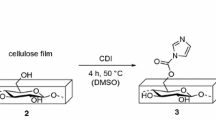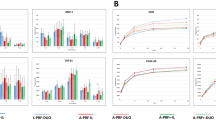Abstract
The development and utilization of a parallel plate flow system to study the blood response to flat sheet biomaterials, is described. Unlike most other parallel plate flow systems, which have been used to study cellular interactions with biomaterials, the controlled flow test cell described below employs the test materials on both sides of the channel through which the blood flows. The flow cell is used to conduct an investigation into the in vitro generation of C3a by a regenerated cellulose membrane, Cuprophan. The effects of experimental variables such as temperature, blood flow rate, contact area and wall shear rate on C3a generation by Cuprophan were studied. The results show that C3a generation by Cuprophan is lower at 12 °C than at 22 °C, which is in turn lower than C3a generation at 37 °C. Furthermore, a decrease in contact area, and increase in wall shear rate and blood flow rate, can produce a decrease in C3a concentration.
Similar content being viewed by others
References
J. Olijslager, in “Blood compatible materials and their testing”, edited by S. Dawids and A. Bantjes (Martinus Nijhoff, Dordrecht, The Netherlands, 1986) pp. 123–8.
H. Klinkmann, in “Biomaterials in Artificial Organs”, edited by J. P. Paul, J. D. S. Gaylor, J. M. Courtney and T. Gilchrist (Macmillan, London, 1984) pp. 1–8.
J. M. Courtney, N. M. K. Lamba, S. Sundaram, and C. D. Forbes, Biomaterials 15 (1994) 737.
P. D. Richardson, S. F. Mohammad, and R. G. Mason, Proc. Eur. Soc. Artif. Organs 4 (1977) 175.
N. Kawagoishi, C. Nojiri, K. Senshu, T. Kido, H. Nagai, T. Kanamori, K. Sakai, H. Koyanagi, and T. Akutsu, Artif. Organs 18 (1994) 588.
T. G. V. Kooten, J. M. Schakenraad, H. C. V. D. Mei, and H. J. Busscher, J. Biomed. Mater. Res. 26 (1992) 725.
S. Usami, H. Chen, Y. Zhao, S. Chien, and R. Skalak, Ann. Biomed. Eng. 21 (1993) 77.
D. Weng, J. D. S. Gaylor, J. M. Courtney, and G. D. O. Lowe, Artif. Organs 15 (1991) 307.
J. S. Hele-Shaw, Nature 588 (1898) 556.
D. Weng, unpublished results (1991).
L. M. Robertson, J. M. Courtney, L. Irvine, C. Jones, and G.D.O. Lowe, Artif. Organs 14 (1990) 41.
S. Wark, MSc University of Strathclyde, Glasgow (1993) p. 66.
G. Chang, D. R. Absolom, A. B. Strong, G. D. Stubley, and W. Zingg, J. Biomed. Mater. Res. 22 (1988) 13.
J. Vienken, and U. Baurmeister, Artif. Organs 11 (1987) 272.
A. Mahiout, H. Meinhold, M. Kessel, M. Schulze, and U. Baurmeister, ibid. 11 (1987) 149.
M. Goldman, N. Lietaer, P. Lambert, C. Thayse, and J.-L. Vanherweghem, Life Support Systems 5 (1987) 317.
D. E. Chenoweth, and L. W. Henderson, Artif. Organs 11 (1987) 155.
R. M. Schaefer, W. Rautenberg, S. Neumann, A. Heidland, W. H. HÖrl, Clin. Nephrol. 26 (1986) 535.
A. T. Nguyen, C. Lethias, J. Zingraff, A. Herbelin, C. Narel, and B. Descamps-Latscha, Kidney Int. 28 (1985) 158.
L. I. Friedman, and E. F. Leonard, Fed. Proc. 30 (1971) 1641.
H. L. Goldsmith, and V. T. Turitto, Thromb. Haemost 55 (1986) 415.
R. S. Wilson, M. D. Lelah, and S. L. Cooper, in “Techniques of biocompatibility testing”, Vol. 11, (edited by D. F. Williams (CRC Press, Boca Raton, FL, 1986) pp. 151–81.
Author information
Authors and Affiliations
Rights and permissions
About this article
Cite this article
Lamba, N.M.K., Gaylor, J.D.S., Courtney, J.M. et al. Complement activation by cellulose: investigation of the effects of time, area, flow rate, shear rate and temperature on C3a generation in vitro, using a parallel plate flow cell. Journal of Materials Science: Materials in Medicine 9, 409–414 (1998). https://doi.org/10.1023/A:1013287614418
Issue Date:
DOI: https://doi.org/10.1023/A:1013287614418




